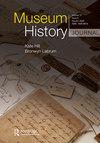Vibrant pasts in museum drawers: Advances in the study of late precolonial (AD 800–1500) materials collected from north-central Venezuela
IF 0.2
Q3 HISTORY
引用次数: 0
Abstract
ABSTRACT Starting in the second half of the nineteenth century, museums and private collectors across the Americas and Europe began amassing objects produced by the indigenous peoples of north-central Venezuela before the European conquest. The rich imagery displayed on decorated pottery and figurines, as well as on skilfully made body ornaments, strongly appealed to the aesthetic tastes of the museum curators and visitors of that time. With some laudable exceptions, most of the excavations that expanded these collections did not follow the archaeological practice standards of our time and did not leave behind any written reports. In consequence, these objects and associated data have remained disconnected from subsequent advances in regional archaeology. In this paper, we provide a general overview of the diverse archaeological collections from the region under study and insert them, critically, into the current understanding of north-central Venezuelan archaeology. We go on to focus on body adornments in order to show how microwear analysis of their production, along with the use wear traces they exhibit, combined with data concerning raw material procurement and depositional contexts, can shed light on the intricacies of the social life of these objects. We argue that up-to-date knowledge of regional archaeology interwoven with new interdisciplinary approaches on museum collections enables researchers to resuscitate the vibrant indigenous pasts lying in museum drawers.博物馆抽屉里充满活力的过去:从委内瑞拉中北部收集的殖民前晚期(公元800-1500年)材料研究进展
从19世纪下半叶开始,美洲和欧洲的博物馆和私人收藏家开始收集欧洲征服前委内瑞拉中北部土著人民生产的物品。在装饰的陶器和小雕像上展示的丰富的意象,以及在熟练制作的身体饰品上,强烈地吸引了当时博物馆馆长和游客的审美情趣。除了一些值得称赞的例外,大多数扩大这些藏品的发掘都没有遵循我们这个时代的考古实践标准,也没有留下任何书面报告。因此,这些物品和相关资料一直与后来的区域考古学进展脱节。在本文中,我们对所研究地区的各种考古收藏品进行了总体概述,并将它们批判性地插入到当前对委内瑞拉中北部考古学的理解中。我们继续关注身体装饰品,以展示它们的生产微磨损分析,以及它们所展示的使用磨损痕迹,结合有关原材料采购和沉积背景的数据,可以揭示这些物品的复杂社会生活。我们认为,区域考古学的最新知识与博物馆藏品的新跨学科方法相结合,使研究人员能够复活躺在博物馆抽屉里的充满活力的土著过去。
本文章由计算机程序翻译,如有差异,请以英文原文为准。
求助全文
约1分钟内获得全文
求助全文

 求助内容:
求助内容: 应助结果提醒方式:
应助结果提醒方式:


